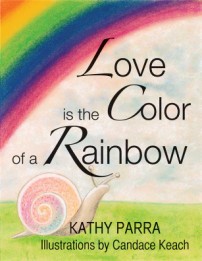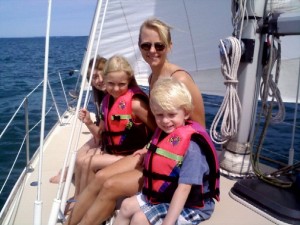API interviewed author Kathy Parra about her children’s book, Love is the Color of a Rainbow.
Tell us about your book. What was the inspiration?
 Love is the Color of a Rainbow is about Willow, a little girl who has been blind since birth. When she hears pit-pats of the first summer rain, she quickly encourages her Mama to go outside. Mama shares all the colors of a rainbow with Willow through nature, and there Willow experiences that “love is the color of a rainbow.”
Love is the Color of a Rainbow is about Willow, a little girl who has been blind since birth. When she hears pit-pats of the first summer rain, she quickly encourages her Mama to go outside. Mama shares all the colors of a rainbow with Willow through nature, and there Willow experiences that “love is the color of a rainbow.”
When I was in the 6th grade, the teacher asked if anyone wanted to assist with the special needs students. I raised my hand and said, “Pick me!” I was paired up with many children, including a girl I will call Willow, who had been blind since birth. Each day I went in to assist her with Braille reading.
One day, out of the blue, Willow took out her pear from her lunch bag and said, “I wish I knew what my pear looked like. Kathy, what does a pear look like?” I started with telling her that it’s green on the outside, and she said, “What does green look like?” I knew then and there I should take her in nature to share what the pear looked like, so I took her under a beautiful mulberry tree in the schoolyard. As she stood under the tree, I took her hand and let her feel the green leaves, and I told her that these are leaves and they are green, and it is the same color as the outside of the pear. “Oh, it is smooth-warm,” she said. Then I ran her hand over the branch, which would be the sense of the stem of the pear, and I said that this is the stem and it is a brownish green. “Oh,” she said, ”this feels smooth yet strong!”
I was excited that she was associating the feel-sense of what I was sharing, putting feelings to the colors. Then I took her to the sand box and ran her fingers through the sand, and I told her the inside of the pear it a soft white color, yet as you bite into the pear, there is just a bit of grit. She ran her fingers through the sand, then taking a bite of pear, she said, “Oh, it feels like life, like it has energy; when I feel the sand and then bite the pear, I feel life-energy!”
Willow quickly began to associate most everything in her daily life with a feeling for a color. She even made up her own colors! Willow often told me I was like a lot of colors put together, saying that all those colors were love. In that short amount of time that we spent together, I was grateful for her friendship and she for mine.
In addition to that experience, my mother encouraged me as a child to be in nature as much as I wished, and I had my own garden at age four, growing various vegetables and such. I took delight in being in the dirt, so to speak. Today I am the mother of three amazing children–all girls, aged 13, 18 and 21. They were an inspiration for me and continue to be so; they have been my greatest teachers. I am honored and blessed to be in the presence of such wisdom.
How will this book benefit families?
The book has been shared with many families from across the globe, and the response received back has been more than heart-warming. Notes have come in to share things like, “Thank you for your book; it gave me a an opportunity to share with special needs children in such a unique and beautiful way.” Or, “Let us all remember the childlike sense of wonder in this way as we walk through nature.” Many yoga teachers have shared the book to create a sense of oneness.
I believe that this book provides unique ideas about how to be with one’s child in nature in very special ways, perhaps ways that will allow each of us to slow down, take a moment and ponder ideas like: How does a tomato feel, or what does the color blue feel like? Encouraging parents to “just be” for that moment in time with their children can make all the difference in a child’s life. Fostering a parent/child interaction on a nature walk, and in so doing empowering children through their senses in nature, is a wonderful way for children to understand their relationship with earth as interconnectedness, that with nature we are one. It is no secret that children who engage in nature experience less stress, better concentration and increased creativity.
What are your views of Attachment Parenting International and what API is doing? How does your book work within our mission statement?
The journey into motherhood began for me long before conception. Then came breastfeeding, cosleeping, choosing alternative healing/health, shopping in local markets, choosing to unschool the girls so that life is their curriculum, and practicing all of the principles shared by API. I applaud API for continuing to encourage parents to create strong family bonds with their children, for our children are the future gateway to the new world of being. Let us listen to our children, learn and grow from our children, and let our children be children. If we can do this, not only will we have a future generation of children who know themselves and all that surrounds them as a unity, a oneness, but it will also rekindle the childlike sense of wonder within ourselves.
Anything else you’d like to share?
As I share in the opening of the book, “When we look through the eyes of a child, the world becomes what it always is and has been.”
Where can readers find more information?
My website is www.kathyparra.com.
 I have always been of the opinion that days which are 70 degrees and sunny should be declared “National Hooky Days.” After all, what could be more important than getting outside on such a perfect day?
I have always been of the opinion that days which are 70 degrees and sunny should be declared “National Hooky Days.” After all, what could be more important than getting outside on such a perfect day?